Economic Principles and Decision Making - University Assignment
VerifiedAdded on 2021/04/24
|8
|1697
|79
Homework Assignment
AI Summary
This economics assignment delves into core economic principles, focusing on elasticity, revenue, and market structures. The assignment analyzes the concept of elasticity, helping to measure the change in quantity demanded of a commodity when its own price changes, as well as income of its consumers and prices of its related commodities. It also examines how a business owner can use elasticity to maximize profits. The assignment calculates total revenue, price elasticity of demand, and cross-price elasticity. Furthermore, it examines market structures, specifically monopolistic competition, providing insights into how businesses operate within these structures, including the role of advertisement costs in a monopolistically competitive market. The assignment uses the case of Schmeckt Gut energy bars to illustrate these economic concepts.
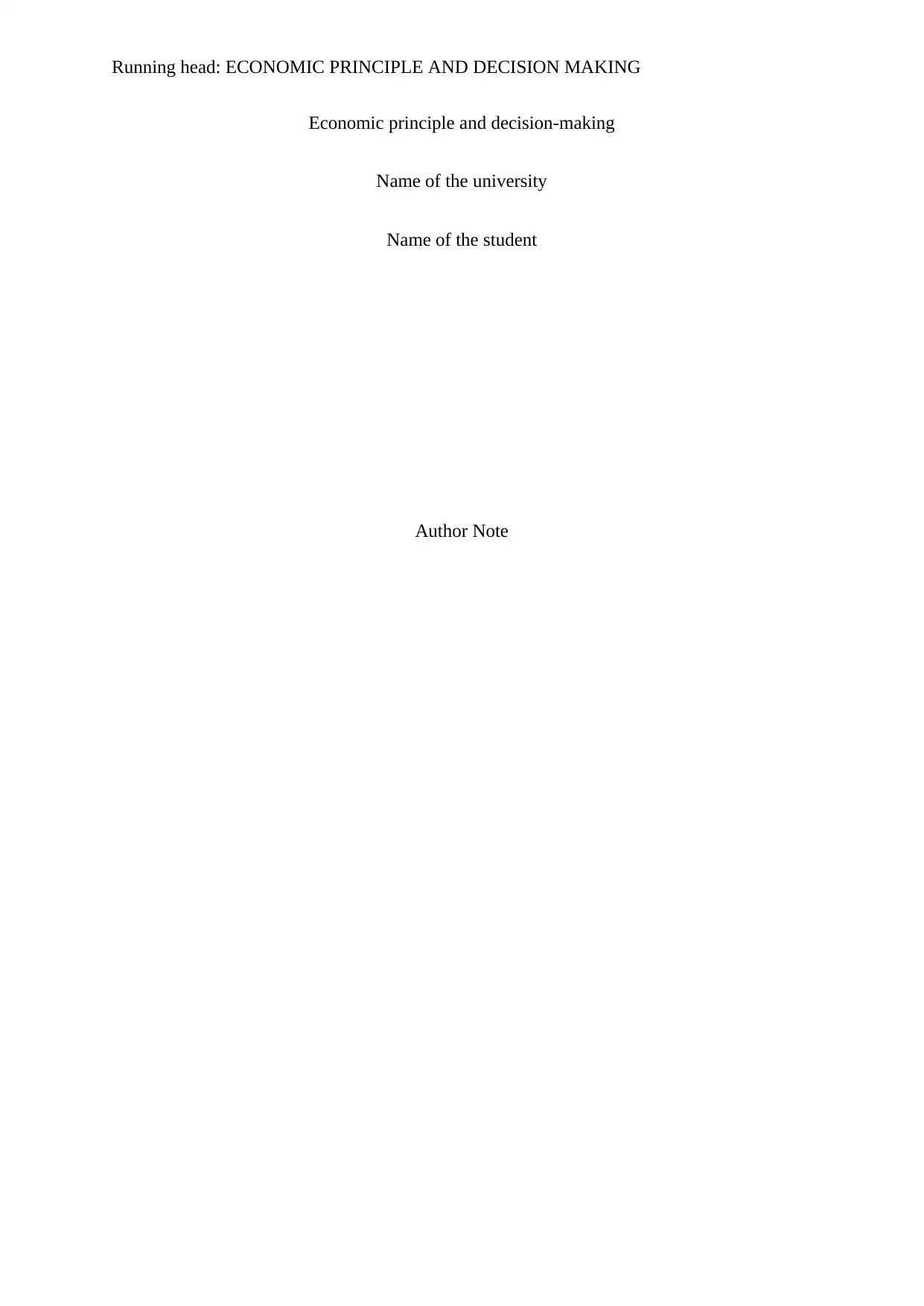
Running head: ECONOMIC PRINCIPLE AND DECISION MAKING
Economic principle and decision-making
Name of the university
Name of the student
Author Note
Economic principle and decision-making
Name of the university
Name of the student
Author Note
Paraphrase This Document
Need a fresh take? Get an instant paraphrase of this document with our AI Paraphraser
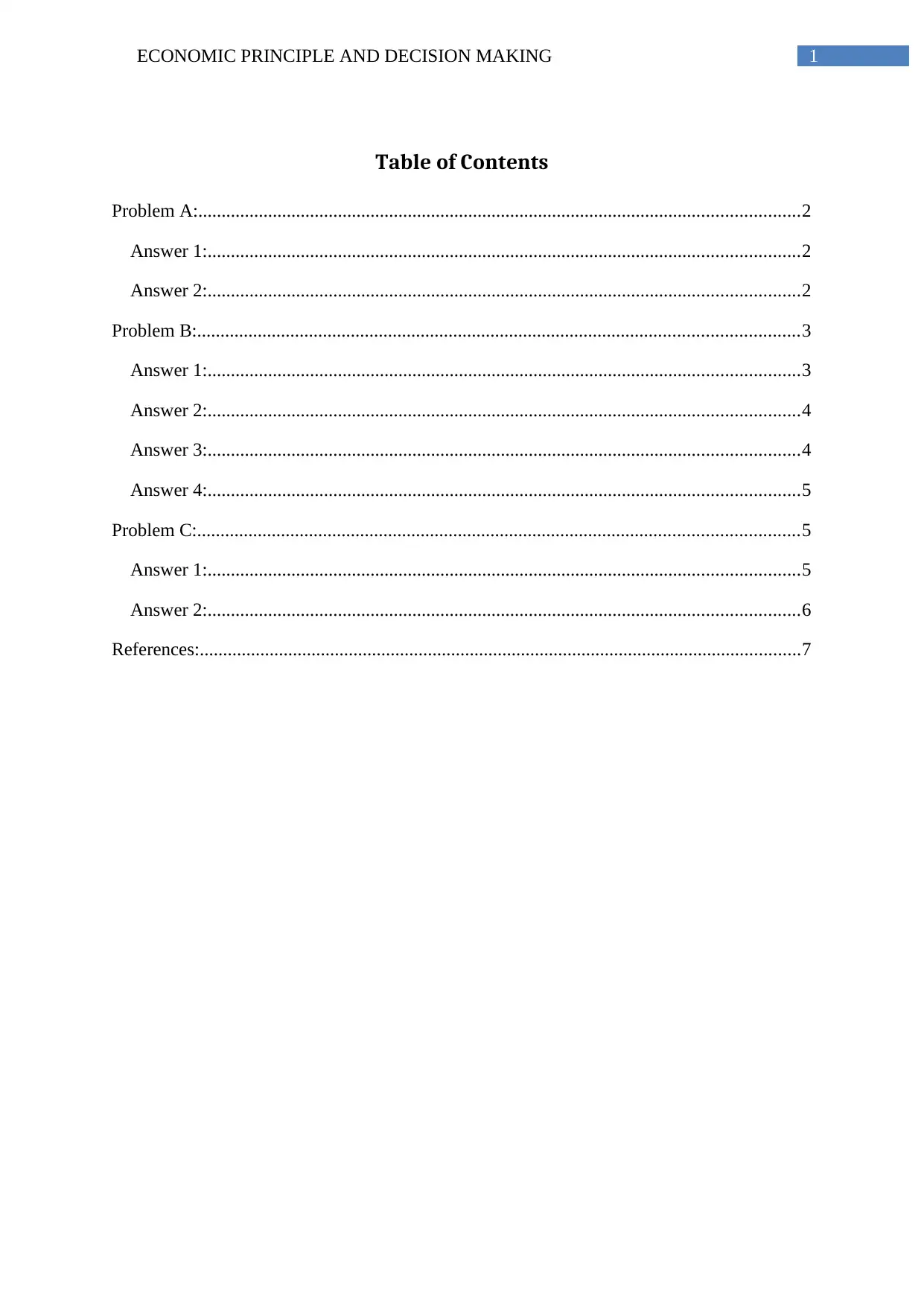
1ECONOMIC PRINCIPLE AND DECISION MAKING
Table of Contents
Problem A:.................................................................................................................................2
Answer 1:...............................................................................................................................2
Answer 2:...............................................................................................................................2
Problem B:.................................................................................................................................3
Answer 1:...............................................................................................................................3
Answer 2:...............................................................................................................................4
Answer 3:...............................................................................................................................4
Answer 4:...............................................................................................................................5
Problem C:.................................................................................................................................5
Answer 1:...............................................................................................................................5
Answer 2:...............................................................................................................................6
References:.................................................................................................................................7
Table of Contents
Problem A:.................................................................................................................................2
Answer 1:...............................................................................................................................2
Answer 2:...............................................................................................................................2
Problem B:.................................................................................................................................3
Answer 1:...............................................................................................................................3
Answer 2:...............................................................................................................................4
Answer 3:...............................................................................................................................4
Answer 4:...............................................................................................................................5
Problem C:.................................................................................................................................5
Answer 1:...............................................................................................................................5
Answer 2:...............................................................................................................................6
References:.................................................................................................................................7
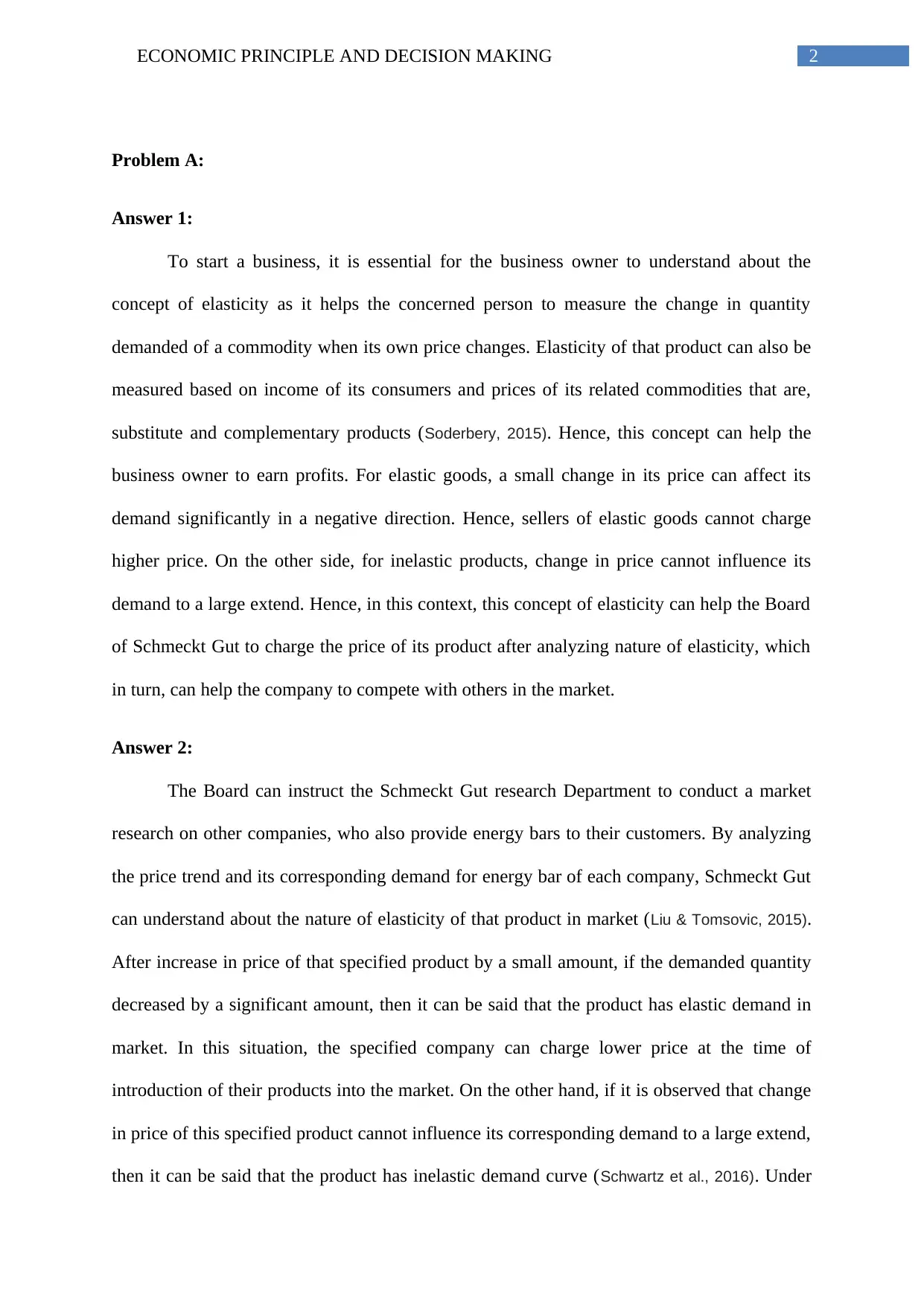
2ECONOMIC PRINCIPLE AND DECISION MAKING
Problem A:
Answer 1:
To start a business, it is essential for the business owner to understand about the
concept of elasticity as it helps the concerned person to measure the change in quantity
demanded of a commodity when its own price changes. Elasticity of that product can also be
measured based on income of its consumers and prices of its related commodities that are,
substitute and complementary products (Soderbery, 2015). Hence, this concept can help the
business owner to earn profits. For elastic goods, a small change in its price can affect its
demand significantly in a negative direction. Hence, sellers of elastic goods cannot charge
higher price. On the other side, for inelastic products, change in price cannot influence its
demand to a large extend. Hence, in this context, this concept of elasticity can help the Board
of Schmeckt Gut to charge the price of its product after analyzing nature of elasticity, which
in turn, can help the company to compete with others in the market.
Answer 2:
The Board can instruct the Schmeckt Gut research Department to conduct a market
research on other companies, who also provide energy bars to their customers. By analyzing
the price trend and its corresponding demand for energy bar of each company, Schmeckt Gut
can understand about the nature of elasticity of that product in market (Liu & Tomsovic, 2015).
After increase in price of that specified product by a small amount, if the demanded quantity
decreased by a significant amount, then it can be said that the product has elastic demand in
market. In this situation, the specified company can charge lower price at the time of
introduction of their products into the market. On the other hand, if it is observed that change
in price of this specified product cannot influence its corresponding demand to a large extend,
then it can be said that the product has inelastic demand curve (Schwartz et al., 2016). Under
Problem A:
Answer 1:
To start a business, it is essential for the business owner to understand about the
concept of elasticity as it helps the concerned person to measure the change in quantity
demanded of a commodity when its own price changes. Elasticity of that product can also be
measured based on income of its consumers and prices of its related commodities that are,
substitute and complementary products (Soderbery, 2015). Hence, this concept can help the
business owner to earn profits. For elastic goods, a small change in its price can affect its
demand significantly in a negative direction. Hence, sellers of elastic goods cannot charge
higher price. On the other side, for inelastic products, change in price cannot influence its
demand to a large extend. Hence, in this context, this concept of elasticity can help the Board
of Schmeckt Gut to charge the price of its product after analyzing nature of elasticity, which
in turn, can help the company to compete with others in the market.
Answer 2:
The Board can instruct the Schmeckt Gut research Department to conduct a market
research on other companies, who also provide energy bars to their customers. By analyzing
the price trend and its corresponding demand for energy bar of each company, Schmeckt Gut
can understand about the nature of elasticity of that product in market (Liu & Tomsovic, 2015).
After increase in price of that specified product by a small amount, if the demanded quantity
decreased by a significant amount, then it can be said that the product has elastic demand in
market. In this situation, the specified company can charge lower price at the time of
introduction of their products into the market. On the other hand, if it is observed that change
in price of this specified product cannot influence its corresponding demand to a large extend,
then it can be said that the product has inelastic demand curve (Schwartz et al., 2016). Under
⊘ This is a preview!⊘
Do you want full access?
Subscribe today to unlock all pages.

Trusted by 1+ million students worldwide
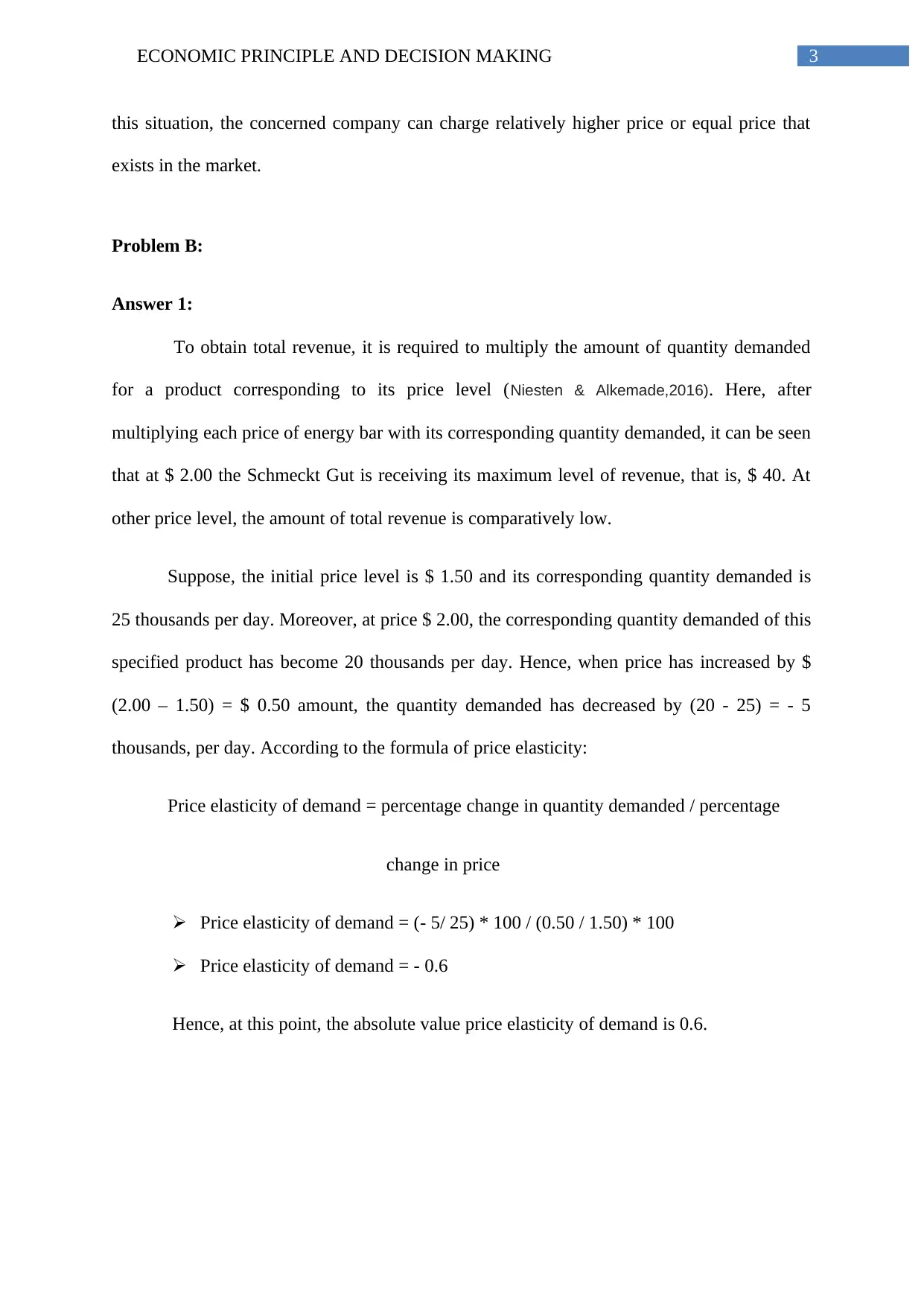
3ECONOMIC PRINCIPLE AND DECISION MAKING
this situation, the concerned company can charge relatively higher price or equal price that
exists in the market.
Problem B:
Answer 1:
To obtain total revenue, it is required to multiply the amount of quantity demanded
for a product corresponding to its price level (Niesten & Alkemade,2016). Here, after
multiplying each price of energy bar with its corresponding quantity demanded, it can be seen
that at $ 2.00 the Schmeckt Gut is receiving its maximum level of revenue, that is, $ 40. At
other price level, the amount of total revenue is comparatively low.
Suppose, the initial price level is $ 1.50 and its corresponding quantity demanded is
25 thousands per day. Moreover, at price $ 2.00, the corresponding quantity demanded of this
specified product has become 20 thousands per day. Hence, when price has increased by $
(2.00 – 1.50) = $ 0.50 amount, the quantity demanded has decreased by (20 - 25) = - 5
thousands, per day. According to the formula of price elasticity:
Price elasticity of demand = percentage change in quantity demanded / percentage
change in price
Price elasticity of demand = (- 5/ 25) * 100 / (0.50 / 1.50) * 100
Price elasticity of demand = - 0.6
Hence, at this point, the absolute value price elasticity of demand is 0.6.
this situation, the concerned company can charge relatively higher price or equal price that
exists in the market.
Problem B:
Answer 1:
To obtain total revenue, it is required to multiply the amount of quantity demanded
for a product corresponding to its price level (Niesten & Alkemade,2016). Here, after
multiplying each price of energy bar with its corresponding quantity demanded, it can be seen
that at $ 2.00 the Schmeckt Gut is receiving its maximum level of revenue, that is, $ 40. At
other price level, the amount of total revenue is comparatively low.
Suppose, the initial price level is $ 1.50 and its corresponding quantity demanded is
25 thousands per day. Moreover, at price $ 2.00, the corresponding quantity demanded of this
specified product has become 20 thousands per day. Hence, when price has increased by $
(2.00 – 1.50) = $ 0.50 amount, the quantity demanded has decreased by (20 - 25) = - 5
thousands, per day. According to the formula of price elasticity:
Price elasticity of demand = percentage change in quantity demanded / percentage
change in price
Price elasticity of demand = (- 5/ 25) * 100 / (0.50 / 1.50) * 100
Price elasticity of demand = - 0.6
Hence, at this point, the absolute value price elasticity of demand is 0.6.
Paraphrase This Document
Need a fresh take? Get an instant paraphrase of this document with our AI Paraphraser
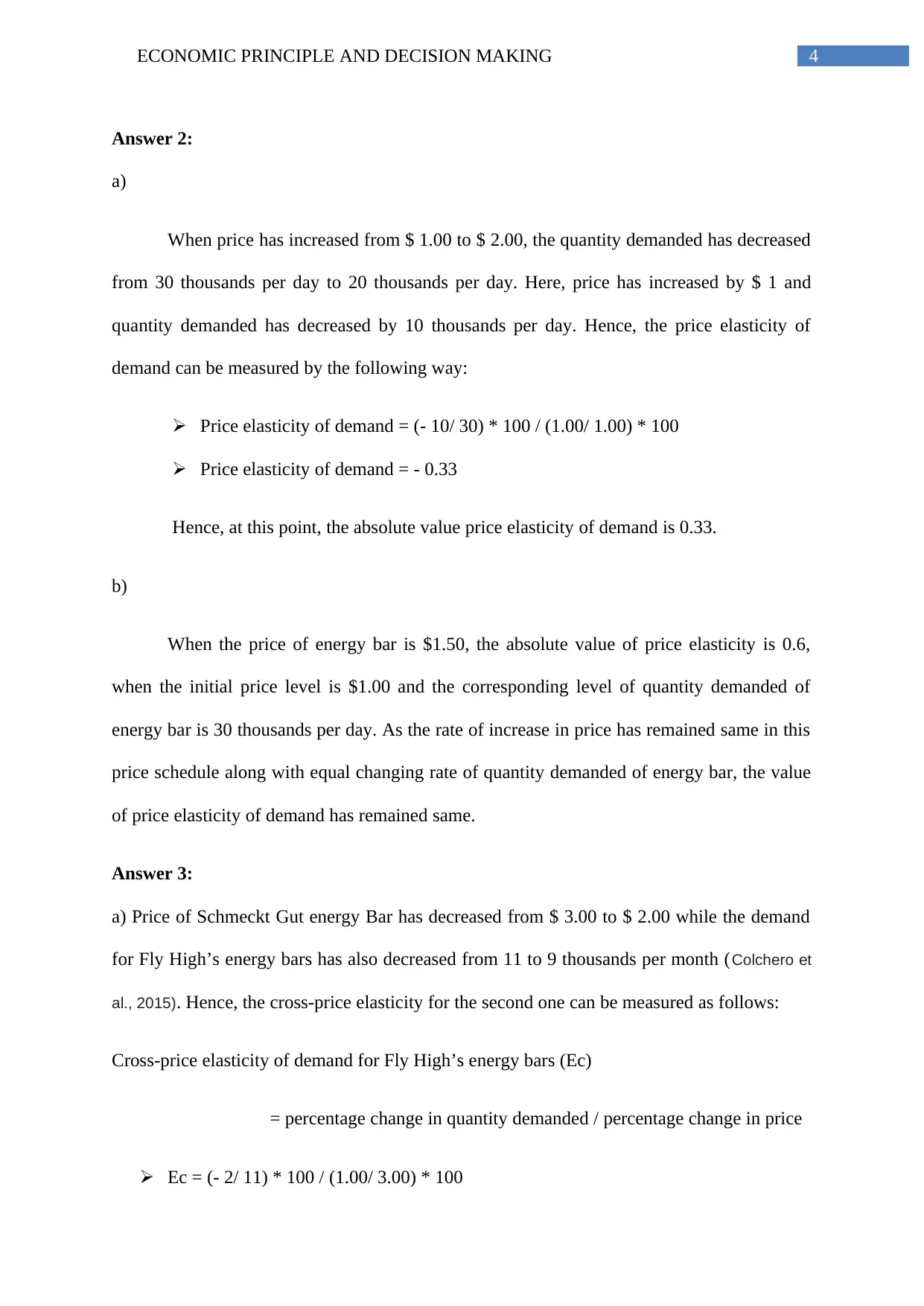
4ECONOMIC PRINCIPLE AND DECISION MAKING
Answer 2:
a)
When price has increased from $ 1.00 to $ 2.00, the quantity demanded has decreased
from 30 thousands per day to 20 thousands per day. Here, price has increased by $ 1 and
quantity demanded has decreased by 10 thousands per day. Hence, the price elasticity of
demand can be measured by the following way:
Price elasticity of demand = (- 10/ 30) * 100 / (1.00/ 1.00) * 100
Price elasticity of demand = - 0.33
Hence, at this point, the absolute value price elasticity of demand is 0.33.
b)
When the price of energy bar is $1.50, the absolute value of price elasticity is 0.6,
when the initial price level is $1.00 and the corresponding level of quantity demanded of
energy bar is 30 thousands per day. As the rate of increase in price has remained same in this
price schedule along with equal changing rate of quantity demanded of energy bar, the value
of price elasticity of demand has remained same.
Answer 3:
a) Price of Schmeckt Gut energy Bar has decreased from $ 3.00 to $ 2.00 while the demand
for Fly High’s energy bars has also decreased from 11 to 9 thousands per month (Colchero et
al., 2015). Hence, the cross-price elasticity for the second one can be measured as follows:
Cross-price elasticity of demand for Fly High’s energy bars (Ec)
= percentage change in quantity demanded / percentage change in price
Ec = (- 2/ 11) * 100 / (1.00/ 3.00) * 100
Answer 2:
a)
When price has increased from $ 1.00 to $ 2.00, the quantity demanded has decreased
from 30 thousands per day to 20 thousands per day. Here, price has increased by $ 1 and
quantity demanded has decreased by 10 thousands per day. Hence, the price elasticity of
demand can be measured by the following way:
Price elasticity of demand = (- 10/ 30) * 100 / (1.00/ 1.00) * 100
Price elasticity of demand = - 0.33
Hence, at this point, the absolute value price elasticity of demand is 0.33.
b)
When the price of energy bar is $1.50, the absolute value of price elasticity is 0.6,
when the initial price level is $1.00 and the corresponding level of quantity demanded of
energy bar is 30 thousands per day. As the rate of increase in price has remained same in this
price schedule along with equal changing rate of quantity demanded of energy bar, the value
of price elasticity of demand has remained same.
Answer 3:
a) Price of Schmeckt Gut energy Bar has decreased from $ 3.00 to $ 2.00 while the demand
for Fly High’s energy bars has also decreased from 11 to 9 thousands per month (Colchero et
al., 2015). Hence, the cross-price elasticity for the second one can be measured as follows:
Cross-price elasticity of demand for Fly High’s energy bars (Ec)
= percentage change in quantity demanded / percentage change in price
Ec = (- 2/ 11) * 100 / (1.00/ 3.00) * 100
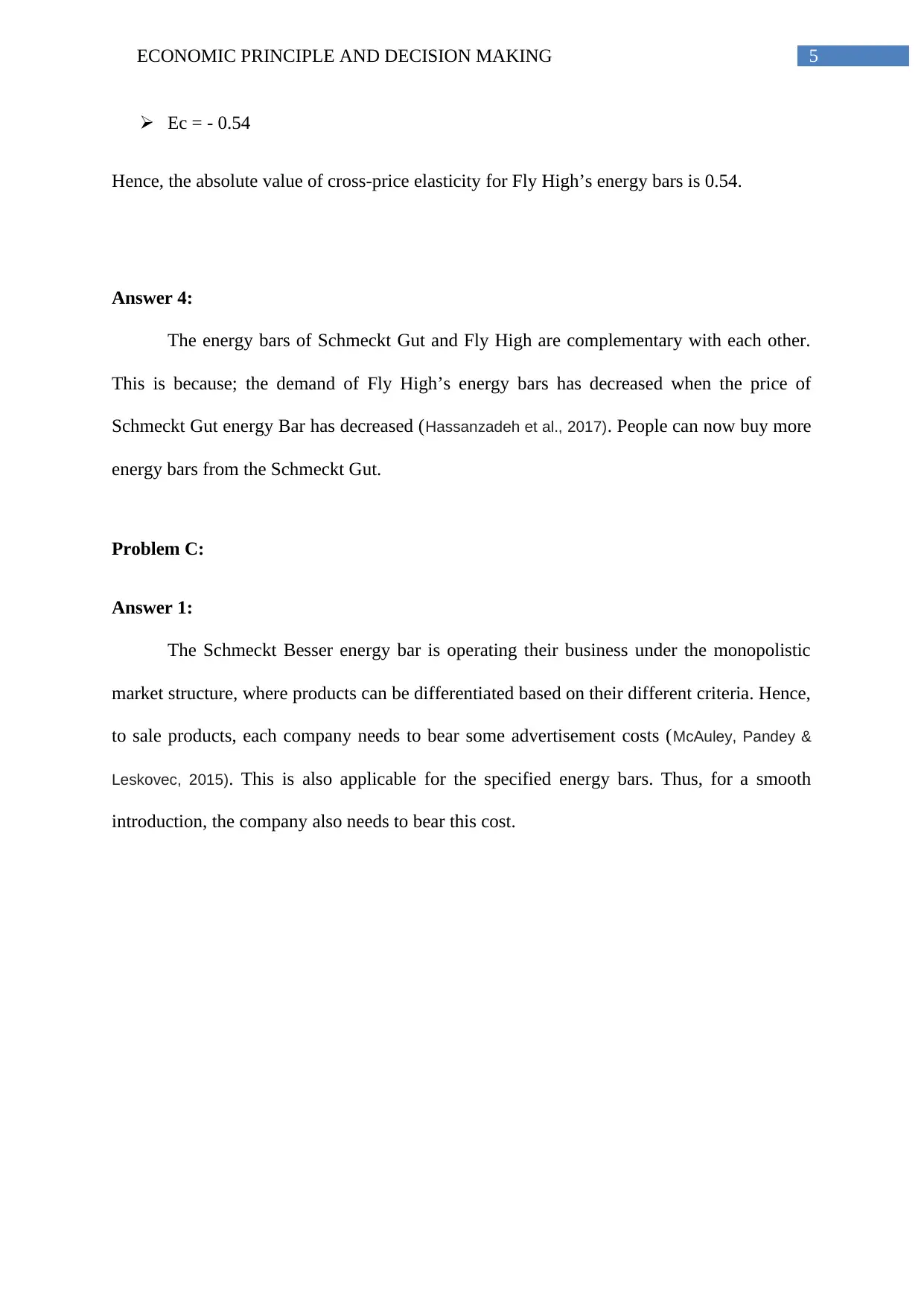
5ECONOMIC PRINCIPLE AND DECISION MAKING
Ec = - 0.54
Hence, the absolute value of cross-price elasticity for Fly High’s energy bars is 0.54.
Answer 4:
The energy bars of Schmeckt Gut and Fly High are complementary with each other.
This is because; the demand of Fly High’s energy bars has decreased when the price of
Schmeckt Gut energy Bar has decreased (Hassanzadeh et al., 2017). People can now buy more
energy bars from the Schmeckt Gut.
Problem C:
Answer 1:
The Schmeckt Besser energy bar is operating their business under the monopolistic
market structure, where products can be differentiated based on their different criteria. Hence,
to sale products, each company needs to bear some advertisement costs (McAuley, Pandey &
Leskovec, 2015). This is also applicable for the specified energy bars. Thus, for a smooth
introduction, the company also needs to bear this cost.
Ec = - 0.54
Hence, the absolute value of cross-price elasticity for Fly High’s energy bars is 0.54.
Answer 4:
The energy bars of Schmeckt Gut and Fly High are complementary with each other.
This is because; the demand of Fly High’s energy bars has decreased when the price of
Schmeckt Gut energy Bar has decreased (Hassanzadeh et al., 2017). People can now buy more
energy bars from the Schmeckt Gut.
Problem C:
Answer 1:
The Schmeckt Besser energy bar is operating their business under the monopolistic
market structure, where products can be differentiated based on their different criteria. Hence,
to sale products, each company needs to bear some advertisement costs (McAuley, Pandey &
Leskovec, 2015). This is also applicable for the specified energy bars. Thus, for a smooth
introduction, the company also needs to bear this cost.
⊘ This is a preview!⊘
Do you want full access?
Subscribe today to unlock all pages.

Trusted by 1+ million students worldwide
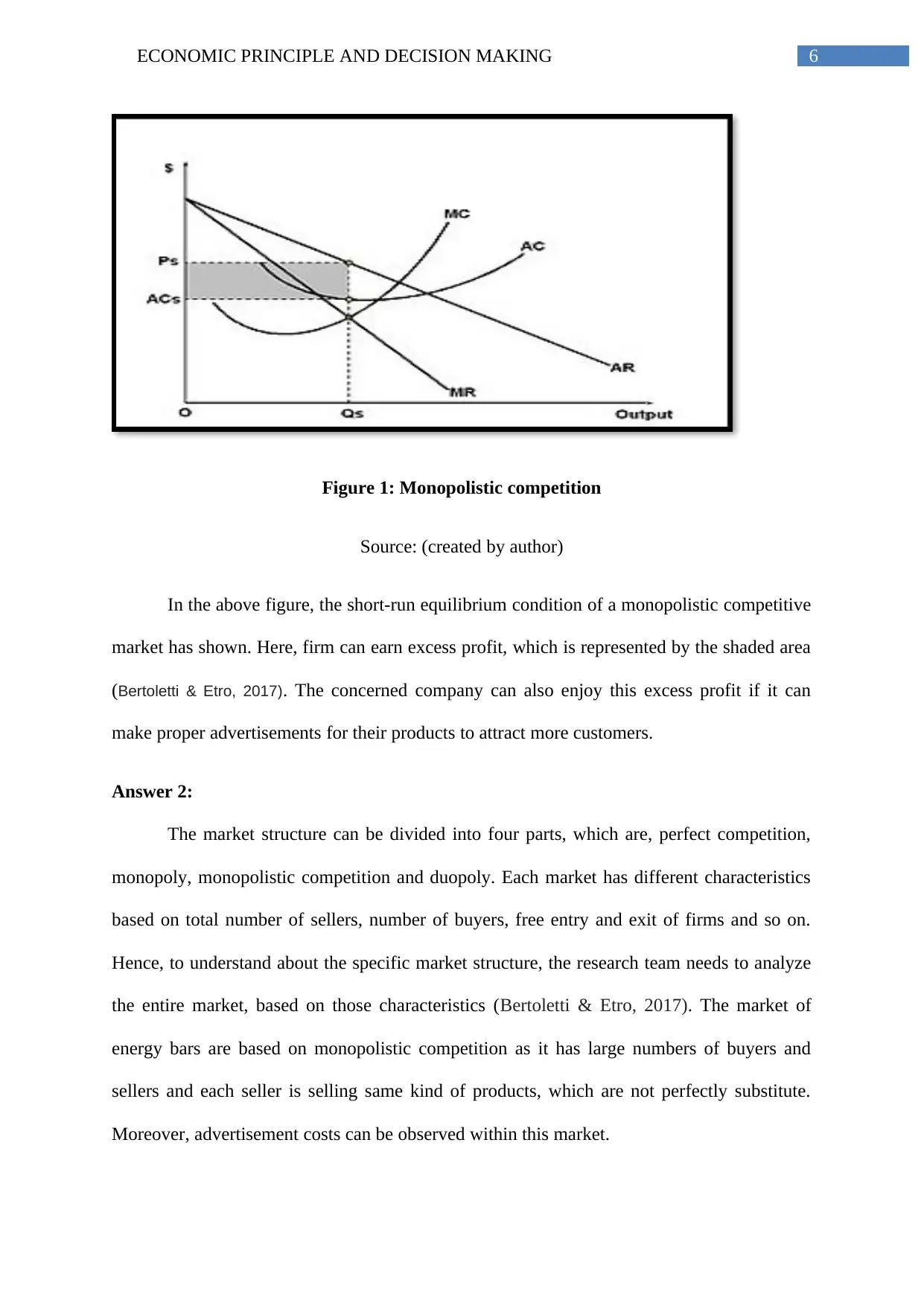
6ECONOMIC PRINCIPLE AND DECISION MAKING
Figure 1: Monopolistic competition
Source: (created by author)
In the above figure, the short-run equilibrium condition of a monopolistic competitive
market has shown. Here, firm can earn excess profit, which is represented by the shaded area
(Bertoletti & Etro, 2017). The concerned company can also enjoy this excess profit if it can
make proper advertisements for their products to attract more customers.
Answer 2:
The market structure can be divided into four parts, which are, perfect competition,
monopoly, monopolistic competition and duopoly. Each market has different characteristics
based on total number of sellers, number of buyers, free entry and exit of firms and so on.
Hence, to understand about the specific market structure, the research team needs to analyze
the entire market, based on those characteristics (Bertoletti & Etro, 2017). The market of
energy bars are based on monopolistic competition as it has large numbers of buyers and
sellers and each seller is selling same kind of products, which are not perfectly substitute.
Moreover, advertisement costs can be observed within this market.
Figure 1: Monopolistic competition
Source: (created by author)
In the above figure, the short-run equilibrium condition of a monopolistic competitive
market has shown. Here, firm can earn excess profit, which is represented by the shaded area
(Bertoletti & Etro, 2017). The concerned company can also enjoy this excess profit if it can
make proper advertisements for their products to attract more customers.
Answer 2:
The market structure can be divided into four parts, which are, perfect competition,
monopoly, monopolistic competition and duopoly. Each market has different characteristics
based on total number of sellers, number of buyers, free entry and exit of firms and so on.
Hence, to understand about the specific market structure, the research team needs to analyze
the entire market, based on those characteristics (Bertoletti & Etro, 2017). The market of
energy bars are based on monopolistic competition as it has large numbers of buyers and
sellers and each seller is selling same kind of products, which are not perfectly substitute.
Moreover, advertisement costs can be observed within this market.
Paraphrase This Document
Need a fresh take? Get an instant paraphrase of this document with our AI Paraphraser
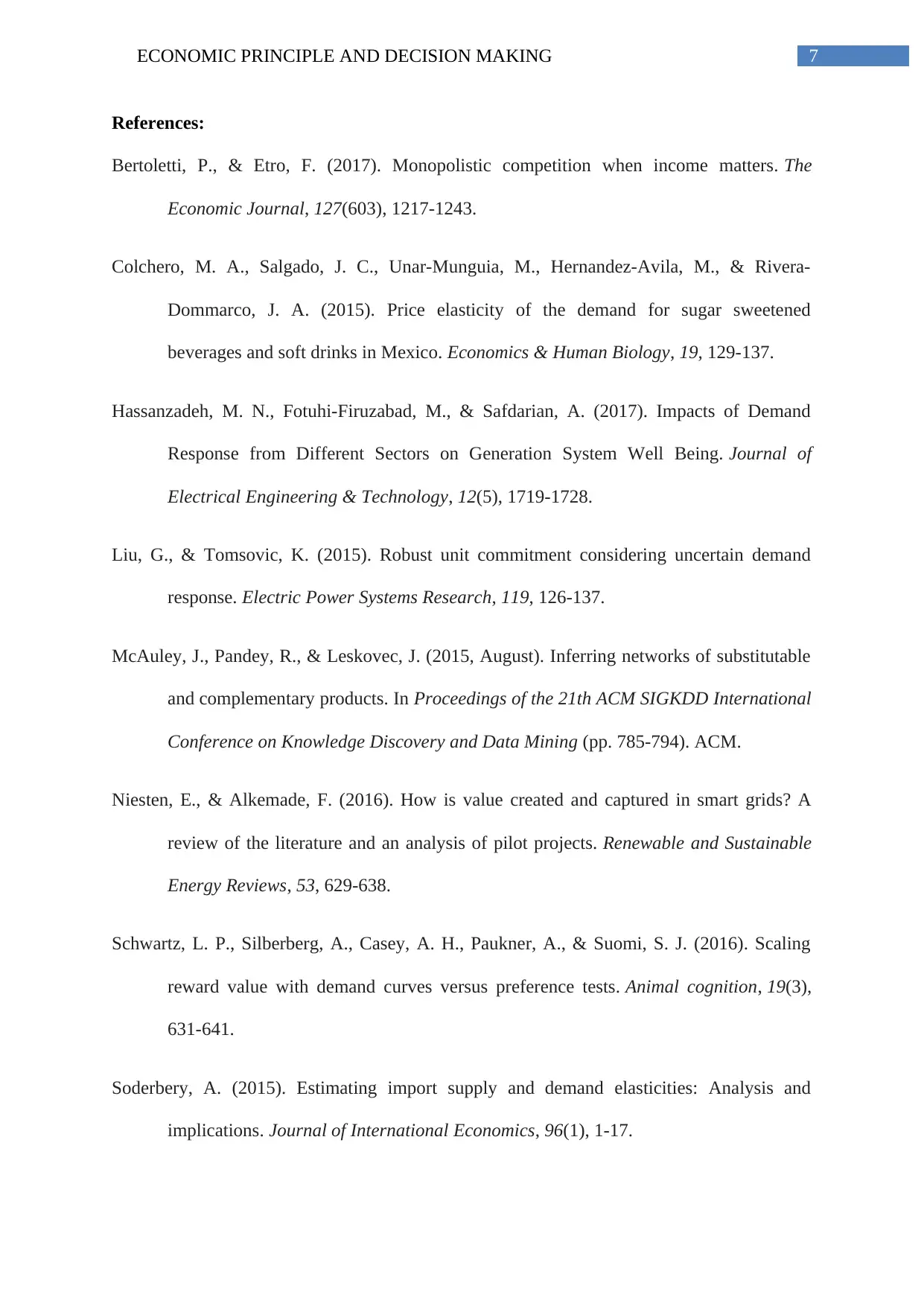
7ECONOMIC PRINCIPLE AND DECISION MAKING
References:
Bertoletti, P., & Etro, F. (2017). Monopolistic competition when income matters. The
Economic Journal, 127(603), 1217-1243.
Colchero, M. A., Salgado, J. C., Unar-Munguia, M., Hernandez-Avila, M., & Rivera-
Dommarco, J. A. (2015). Price elasticity of the demand for sugar sweetened
beverages and soft drinks in Mexico. Economics & Human Biology, 19, 129-137.
Hassanzadeh, M. N., Fotuhi-Firuzabad, M., & Safdarian, A. (2017). Impacts of Demand
Response from Different Sectors on Generation System Well Being. Journal of
Electrical Engineering & Technology, 12(5), 1719-1728.
Liu, G., & Tomsovic, K. (2015). Robust unit commitment considering uncertain demand
response. Electric Power Systems Research, 119, 126-137.
McAuley, J., Pandey, R., & Leskovec, J. (2015, August). Inferring networks of substitutable
and complementary products. In Proceedings of the 21th ACM SIGKDD International
Conference on Knowledge Discovery and Data Mining (pp. 785-794). ACM.
Niesten, E., & Alkemade, F. (2016). How is value created and captured in smart grids? A
review of the literature and an analysis of pilot projects. Renewable and Sustainable
Energy Reviews, 53, 629-638.
Schwartz, L. P., Silberberg, A., Casey, A. H., Paukner, A., & Suomi, S. J. (2016). Scaling
reward value with demand curves versus preference tests. Animal cognition, 19(3),
631-641.
Soderbery, A. (2015). Estimating import supply and demand elasticities: Analysis and
implications. Journal of International Economics, 96(1), 1-17.
References:
Bertoletti, P., & Etro, F. (2017). Monopolistic competition when income matters. The
Economic Journal, 127(603), 1217-1243.
Colchero, M. A., Salgado, J. C., Unar-Munguia, M., Hernandez-Avila, M., & Rivera-
Dommarco, J. A. (2015). Price elasticity of the demand for sugar sweetened
beverages and soft drinks in Mexico. Economics & Human Biology, 19, 129-137.
Hassanzadeh, M. N., Fotuhi-Firuzabad, M., & Safdarian, A. (2017). Impacts of Demand
Response from Different Sectors on Generation System Well Being. Journal of
Electrical Engineering & Technology, 12(5), 1719-1728.
Liu, G., & Tomsovic, K. (2015). Robust unit commitment considering uncertain demand
response. Electric Power Systems Research, 119, 126-137.
McAuley, J., Pandey, R., & Leskovec, J. (2015, August). Inferring networks of substitutable
and complementary products. In Proceedings of the 21th ACM SIGKDD International
Conference on Knowledge Discovery and Data Mining (pp. 785-794). ACM.
Niesten, E., & Alkemade, F. (2016). How is value created and captured in smart grids? A
review of the literature and an analysis of pilot projects. Renewable and Sustainable
Energy Reviews, 53, 629-638.
Schwartz, L. P., Silberberg, A., Casey, A. H., Paukner, A., & Suomi, S. J. (2016). Scaling
reward value with demand curves versus preference tests. Animal cognition, 19(3),
631-641.
Soderbery, A. (2015). Estimating import supply and demand elasticities: Analysis and
implications. Journal of International Economics, 96(1), 1-17.
1 out of 8
Related Documents
Your All-in-One AI-Powered Toolkit for Academic Success.
+13062052269
info@desklib.com
Available 24*7 on WhatsApp / Email
![[object Object]](/_next/static/media/star-bottom.7253800d.svg)
Unlock your academic potential
Copyright © 2020–2025 A2Z Services. All Rights Reserved. Developed and managed by ZUCOL.





